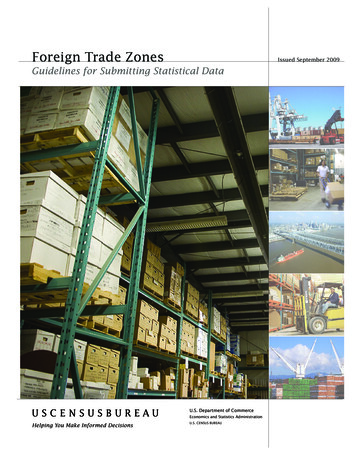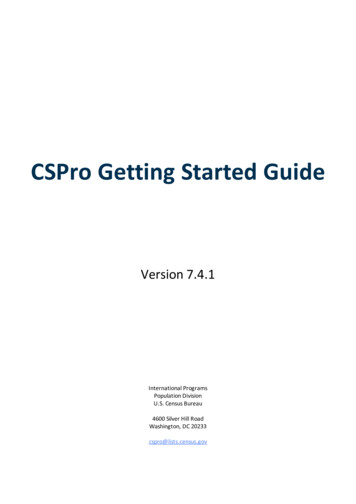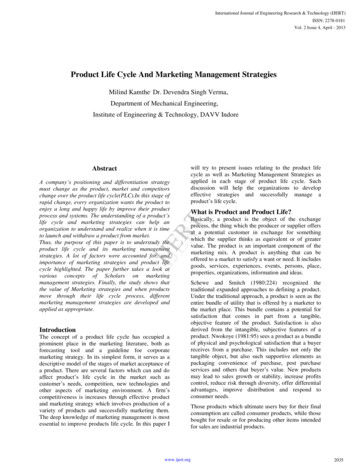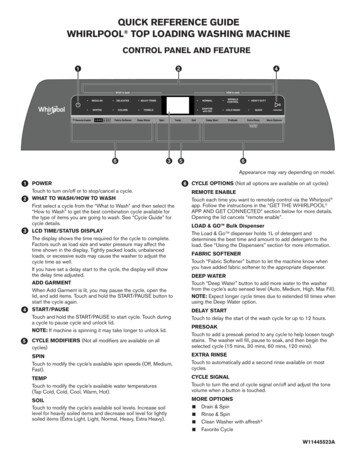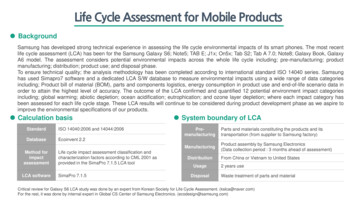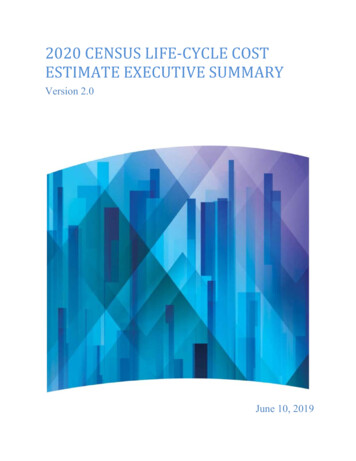
Transcription
2020 CENSUS LIFE‐CYCLE COSTESTIMATE EXECUTIVE SUMMARYVersion 2.0June 10, 2019
Life-cycle Cost Estimate Approval2020 CENSUSLIFE‐CYCLE COST ESTIMATE (LCCE)VERSION 2.0JUNE 10, 2019Submitted by:Approved by:Endorsed by:Version 2.0Electronically ApprovedJune 10, 2019Benjamin K. TaylorChief, Decennial Budget OfficeDateElectronically ApprovedJune 10, 2019Albert E. Fontenot Jr.Associate Director for Decennial CensusProgramsDateElectronically ApprovedJune 10, 2019Everett G. WhiteleyOn Behalf: Chief Financial Officer, CensusBureauDateJune 10, 2019
[Page intentionally left blank]Version 2.0June 10, 2019
Table of .5.15.25.35.45.55.66.INTRODUCTION. 1EXECUTIVE SUMMARY PURPOSE . 1THE ROLE OF THE LCCE . 1IMPROVING THE LCCE . 1HIGH LEVEL COMPARISON TO PREVIOUS VERSION OF THE 2020 CENSUS LCCE. 3BACKGROUND & SCOPE . 4PROGRAM BACKGROUND AND CHARACTERISTICS . 4SCOPE OF THE ESTIMATE . 11COST ESTIMATION APPROACH . 12COST ESTIMATION METHODOLOGY . 12RISK ANALYSIS . 14ESTIMATION TOOLS . 17GROUND RULES & ASSUMPTIONS . 18INFLATION . 18MAJOR ASSUMPTIONS . 18POINT ESTIMATE & RISK ADJUSTMENTS . 19THE COST ESTIMATION RESULTS . 19DETAILED COSTS BY WBS CATEGORY . 21IT COSTS. 29LEADING ELEMENTS OF COST . 31PROGRAM RISK RESERVES AND CONTINGENCY . 32INDEPENDENT COST REVIEWS . 34CONCLUSION . 36Version 2.0June 10, 2019
[Page intentionally left blank]Version 2.0June 10, 2019
2020 Census Life-cycle Cost Estimate Executive SummaryPage 11. INTRODUCTION1.1 Executive Summary PurposeThis executive summary of the 2020 Decennial Census Life-cycle Cost Estimate (LCCE)provides a high-level overview of the June 2019 version of 2020 Census LCCE and thesupporting 2020 Decennial Census LCCE Basis of Estimate (BoE). The executive summaryconstitutes Version 2.0 of the 2020 Decennial Census LCCE. It incorporates updates to theVersion 1.0 Executive Summary issued December 21, 2017. These updates primarily includerealigning cost data within the Work Breakdown Structure (WBS) to more accurately reflect howactivities are managed and planned, updating the estimate to reflect actual costs through FY2018, integrating FY 2018 End-to-End Census Test results, and incorporating final definitivescope details for major contracts and field operationsThe executive summary is prepared for public release and does not include details of thetechnical approach, program design, assumptions, model calculations, cost breakouts, etc.Detailed documentation of the 2020 Census LCCE is contained in the BoE. The BoE is thedetailed formal documentation of the cost estimate that is not published for the general public,but rather is intended for official government use, including by auditors and oversight bodies.1.2 The Role of the LCCEThe LCCE is the estimated cost of developing, producing, deploying, maintaining, operating anddisposing of a program or system over its entire lifespan. The LCCE is prepared in order tosupport and inform program change decisions, major program reviews, resource allocation tradeoff analyses, budget requirements, and source selections. The LCCE provides the basis for theofficial projected cost for a program or system that is communicated to the Department ofCommerce (DOC), the Office of Management and Budget (OMB), Congress, the GovernmentAccountability Office (GAO), and others.As the basis for the official projected cost of the program, the LCCE provides Census Bureauand DOC leadership with critical information for making program decisions, monitoringresource allocations, establishing executable budgets, and proactively addressing financial issues.1.3 Improving the LCCEThe Census Bureau has demonstrably improved the quality of the 2020 Census LCCE. Theresults from the Census Bureau’s significant efforts have been recognized in GAO’s August2018 assessment of the 2020 Census LCCE, as reported in the 2017 Version 1.0 ExecutiveSummary. In this assessment, the GAO found that “ the Census Bureau has made significantprogress in improving its ability to develop a reliable cost estimate”.Figure 1: Comparison of 2015 and 2017 GAO AssessmentsVersion 2.0June 10, 2019
2020 Census Life-cycle Cost Estimates Executive SummaryPage 2(shown below), taken from the August 2018 GAO assessment document1, illustrates the extentand scale of improvement between their assessments of the 2015 and 2017 LCCE versions.2015 Assessment 2017 AssessmentWell-Documented Accurate( ) Partially Met'9Substantially MetCredible Minimally Met'9Substantially MetComprehensive()Partially MetMeta() Partially MetSubstantially MetSource: GAO analysis of U.S. Census Bureau data.Minimally MetI( ) Partially Met-Met Minimally MetO Not MetGA0-1 8-635Figure 1: Comparison of 2015 and 2017 GAO Assessments2The GAO did not make any new recommendations in their August 2018 assessment (see the2017 assessment column referenced in Figure 1 above). Accordingly, the Census Bureaucontinues to work on recommendations contained in the June 2016, GAO report3 on theirassessment of the 2015 version of the 2020 Census LCCE. These recommendations are listedbelow.1. To help ensure the Bureau produces a reliable cost estimate for the 2020 Census, take thefollowing steps to meet the characteristics of a high-quality estimate:a. Comprehensive—among other practices, ensure the estimate includes all lifecycle costs and documents all cost-influencing assumptions.b. Well-documented—among other practices, ensure that its planned documentationplan captures the source data used; contains the calculations performed and the12020 CENSUS Census Bureau Improved the Quality of Its Cost Estimation but Additional Steps Are Needed toEnsure Reliability, August 2018, GAO-18-635, page 2.2The dates of the assessments in the figure below refer to the date of the LCCE assessed rather than the release dateof the GAO assessment report (which is 2016 and 2018, respectively).32020 Census: Census Bureau Needs to Improve Its Life-Cycle Cost Estimating Process, June 30, 2016, GAO-16628Version 2.0June 10, 2019
2020 Census Life-cycle Cost Estimates Executive SummaryPage 3estimating methodologies used for each element; and describes step by step howthe estimate was developed.c. Accurate—among other practices, ensure the estimating technique for each costelement is used appropriately and that variances between planned and actual costare documented, explained, and reviewed.d. Credible—among other practices, ensure the estimate includes a sensitivityanalysis, major cost elements are cross-checked to see whether results are similar,and an independent cost estimate is conducted to determine whether otherestimating methods produce similar results.2. To further ensure the credibility of data used in cost estimation, establish clear guidanceon when information for cost assumptions can and should be changed as well as theprocedures for documenting such changes and traceable sources for information beingused.3. To ensure Bureau and congressional confidence that the Bureau’s budgeted contingenciesare at appropriate levels, improve control over how risk and uncertainty are accounted forand communicated with the Bureau’s decennial cost estimation process, such as byimplementing and institutionalizing processes or methods for doing so with clearguidance.The Census Bureau has improved across all of these recommendations and intends to continuebuilding upon the success that it has achieved in maturing the 2020 Census LCCE. Table 1:Examples of Ongoing LCCE Enhancements below describes examples of ongoing improvementefforts by the Decennial Program.Table 1: Examples of Ongoing LCCE EnhancementsEnhancementIncrease Understanding ofInformation Technology and MajorContracts Improve Program Inputs /Assumptions Improve Basis for Cost Managementand Integration DescriptionDeveloping an application to manage major contract expensesDeeper involvement of contracts management subject matterexperts and decennial leadershipWorking with programs to reflect operational refinements and2018 End‐to‐End Test resultsDeeper involvement of operational subject matter experts anddecennial leadershipDeveloping Cost Estimation and Analysis Process and relatedgovernance artifactsUsing the LCCE as a management tool to inform operationaldecisions1.4 High Level Comparison to Previous Version of the 2020 Census LCCEThe current 2020 Census LCCE, as reported in the June 2019 Executive Summary Version 2.0,is 15.6 billion. This is unchanged from the total LCCE cost reported in the December 2017Executive Summary Version 1.0. Table 2 below shows a comparison between October 2017 andMay 2019 LCCE. There have been changes among different elements of the WBS (see SectionVersion 2.0June 10, 2019
2020 Census Life-cycle Cost Estimates Executive SummaryPage 42.2 below) and risk within the same total cost. Additionally, the confidence level in the total costhas risen since the previous version as illustrated in a greater risk and contingency reserve withinthe same overall total.Table 2: LCCE Cost Comparison of October 2017 vs. June 2019 (in Millions)ElementLCCE Oct 20171 ‐ Program ManagementLCCE June 2019% Change 625 6819% 1,822 2,00910% 732 690‐6%4 ‐ Response Data 5,375 4,988‐7%5 ‐ Published Data 219 2200%6 ‐ Test, Evaluation, Special Censuses 791 777‐2% 3,454 3,376‐2% 13,018 12,740‐2% 1,056 1,40333% 14,074 14,1430.5% 369 300‐19% 1,182 1,1820% 15,625 15,6250%2 ‐ Census/Survey Engineering3 ‐ Frame7 ‐ InfrastructurePoint Estimate SubtotalRisk‐Based ContingencyPoint Estimate Subtotal, with Risk‐Based ContingencyAdditional Sensitivity AnalysisSecretarial ContingencyRisk‐adjusted Total2. BACKGROUND & SCOPE2.1 Program Background and CharacteristicsThe goal of the 2020 Census is to count everyone once, only once, and in the right place. As thecost of completing this goal has significantly increased each decade since 1970 as the populationbecomes more challenging to count, the Census Bureau undertook a challenge this decade todesign the 2020 Census to control cost growth, while continuing to maintain high quality results.The actual cost of the 2010 Census in 2020 inflation-adjusted dollars was 92 per housing unit,while Congress appropriated 106 per housing unit.4 Comparatively, the 2020 Census, as4In FY 2010-2011 the Census Bureau returned nearly 1.9 billion in unused appropriations from the 2010 Census.Version 2.0June 10, 2019
2020 Census Life-cycle Cost Estimates Executive SummaryPage 5currently designed, is expected to cost 108 per housing unit in 2020 inflation-adjusted dollarsincluding usage of all estimated contingency and 87 per housing unit without estimatedcontingency. The level of contingency funds ultimately required to conduct a 2020 Census of thehighest quality will determine whether the actual inflation-adjusted cost per housing of the 2020Census is higher or lower than that of the 2010 Census. To optimize operational efficiency whilemaintaining quality, the Census Bureau will conduct the most automated, modern, and dynamicdecennial census in history.The goal this decade is to design the 2020 Census for the 21st Century in a way that embracestechnology to ensure a high quality 2020 Census that will lay the framework for future censusesfor decades to come. This will be the first decennial census to update the Census Bureau’saddress frame using geographic information systems and aerial imagery instead of sendingcensus employees to walk and physically check all 11 million census blocks; the first toencourage the population to respond to the 2020 Census using the Internet and over thetelephone, reducing the need for expensive paper data capture; the first to use data the public hasalready provided to the government and data available from commercial sources to enablefocusing of additional visits in areas that have traditionally been hard to enumerate; and the firstto use sophisticated operational control systems to send Census Bureau employees to followupwith nonresponding housing units and to track daily progress.The 2020 CensusThe purpose of the 2020 Census is to conduct an accurate count of the population and housing todisseminate the results to the President, the States, and the American people. To accomplish this,the Census Bureau must count everyone once, only once, and in the right place. The challengethis decade has been to do so at a lower cost per household (adjusted for inflation) than the 2010Census. As the 2020 Census draws near, the Census Bureau has designed a 2020 Census thatensures the coverage of the population and housing is as complete as possible. The design willserve to minimize the undercounting or overcounting of the population, particularly as related tothe differential impact on subgroups of the population.5 The Census Bureau is fully committed todesigning and conducting a 2020 Census that fairly represents every person in America.The primary requirement served by the decennial census is the apportionment of seats allocatedto the states for the House of Representatives. This requirement is mandated in the U.S.Constitution:Article I, Section 2, “The actual enumeration shall be made within three years after the firstmeeting of the Congress of the United States, and within every subsequent Term of tenYears”5A detailed discussion of the quality implications of the 2020 Census design can be found in Chapter 7 of the 2020Census Operational Plan Version 4.0.Version 2.0June 10, 2019
2020 Census Life-cycle Cost Estimates Executive SummaryPage 6Fourteenth Amendment, Section 2, “Representatives shall be apportioned among theseveral States according to their respective numbers, counting the whole number ofpersons in each State”Uses of Decennial Census DataAs discussed above, decennial data are used to apportion the number of seats in Congress amongthe states. At the census block level, the data informs governmental entities for redistricting, (i.e.,defining the representative boundaries for congressional districts, state legislative districts,school districts, and voting precincts). Additionally, decennial data help enforce voting rightsand civil rights.The Census Bureau also uses the decennial census results to determine the statistical samplingframes for the American Community Survey (ACS), which replaced the long form in thedecennial census, and the dozens of current surveys conducted by the Census Bureau. The resultsof these surveys are used to support important functions, such as appropriating federal funds tolocal communities (an estimated 675 billion annually6); calculating monthly unemployment,crime, and poverty rates; and publishing health and education data.Finally, decennial data play an increasingly important role in United States commerce and theeconomy. As people expand their use of data to make decisions at the local and national levels,they increasingly depend on data from the Census Bureau to make these decisions. Today, localbusinesses look at data provided by the Census Bureau on topics like population growth andincome levels to make decisions about whether or where to locate their restaurants or stores.Similarly, a real estate investor, who is considering investing significant funds to develop a pieceof land in the community, relies on Census Bureau data to measure the demand for housing,predict future need, and review aggregate trends. Big businesses also rely heavily on CensusBureau data to make critical decisions that impact their success and shape the economy at thenational level. As noted above, the decennial census is the foundation for the Census Bureau’sdemographic survey data.The decennial data must meet high quality standards to ensure good decision-making and tocontinue building confidence in the government, society, and the economy. Studying the balancebetween cost and quality is an important focus of the census design.6Marisa Hotchkiss and Jessica Phelan, Uses of Census Bureau Data in Federal Funds Distribution: A New Designfor the 21st Century, Census Working Papers, 2017 (Washington, DC: U.S. Census Bureau, September 2017), p. 3.Version 2.0June 10, 2019
2020 Census Life-cycle Cost Estimates Executive SummaryPage 7Challenging Environmental FactorsThe 2020 Census challenge is exacerbated by multiple environmental factors that have thepotential to impact its success. The Census Bureau is committed to proactively addressing thechallenges outlined below in Figure ologyMobilePopulationInformal rsityInformationExplosionDistrust inGovernmentDecliningResponseRatesFigure 2: 2020 Census Environment Constrained fiscal environment: Federal budget constraints placed significantpressure on funding available for research, testing, design, and development work forsuccessful innovation.7 Rapidly changing use of technology: Stakeholders expect the decennial census touse technology innovation, yet the rapid pace of change makes it challenging to planfor and adequately test the use of these technologies because they become obsolete. Information explosion: Rapid changes in information technology create stakeholderexpectations for how the Census Bureau interacts with the public to obtain anddisseminate data products.7A detailed discussion of the major program risks can be found in Chapter 6 of the 2020 Census Operational PlanVersion 4.0.Version 2.0June 10, 2019
2020 Census Life-cycle Cost Estimates Executive SummaryPage 8 Distrust in government: The public’s concerns about information security andprivacy, the confidentiality of information given to the government, and howgovernment programs will use the information they collect continue to grow. Thisimpacts response rates and could make it more difficult for government agencies tocollect important demographic information. Declining response rates: Response rates for Census Bureau surveys, and forsurveys and censuses in general, have declined as citizens are overloaded withrequests for information and become increasingly concerned about sharinginformation. Increasingly diverse population: The demographic and cultural make-up of theUnited States continues to increase in complexity, including a growing number ofhouseholds and individuals with limited English proficiency; who may experiencelanguage barriers to enumeration and who may have varying levels of comfort withgovernment involvement. Informal, complex living arrangements: Households are becoming more diverseand dynamic, making it a challenge to associate an identified person with a singlelocation. For example, blended families may include children who have two primaryresidences. Additionally, some households include multiple relationships andgenerations. A mobile population: The United States continues to be a highly mobile nation asabout 14.3 percent of the population moves in a given year, based on results from theAmerican Community Survey conducted in 2017. Continued growth in cellulartelephone technology and an associated reduction in landline telephones tied tophysical locations may also complicate enumeration.A New Design for the 21st CenturySeveral of the societal, demographic, and technological trends listed above can result in apopulation that is harder and more expensive to enumerate. As it becomes more challenging tolocate individuals and solicit their participation through traditional methods, the Census Bureaumust, decade after decade, spend more money simply to maintain the same level of accuracy asprevious censuses. With the innovations described in the 2020 Census Operational Plan Version4, the Census Bureau estimates that billions of dollars can be saved relative to replicating adesign similar to that of the 2010 Census.Field costs associated with Address Canvassing and Nonresponse Followup operations comprisethe most expensive aspects of the 2020 Census. Four innovation areas are aimed at reducing thecosts of fieldwork. A reengineered Address Canvassing operation is expected to reduce the fieldworkload for address updating by 60 to 65 percent. Self-response innovations, which are aimedVersion 2.0June 10, 2019
2020 Census Life-cycle Cost Estimates Executive SummaryPage 9at generating the largest possible self-response rate, coupled with the use of administrativerecords and third-party data, are intended to reduce the field workload associated withNonresponse Followup. Finally, the reengineered field operations are intended to increase theefficiency of those operations, allowing managers and fieldworkers to be more productive andeffective.Figure 3: The 2020 Census - A New Design for the 21st Century describes at a high-level howthe 2020 Census will be conducted. This design reflects a flexible approach that takes advantageof new technologies and data sources while minimizing risk.The 2020 CensusOperationalOverviewCount everyone once,only once, and in the right place.ESTABLISHWHERETOCOUNTMOTIVATEPEOPLE TORESPOND-. :1. ·-----d,-- Ccno.cia i llW'!liNIand oflf.nalian· WOii .,,i, "'8IIOd MUCCIOklixniilUlilp Minm:n n-fidd wiorlr,.;, i , - u. 1o--.Didanllfy 41.toU Yd\Gc:i1 bcaf ITCJnl lnp.:Ll.lakooHGJ'bpooplo1a, .iany,m,,an .E, ,,.19. poq:,lo ., -T""9"I--, .,spod!ic alD'JIXos.t»Ueo lho med crffoarwo """'9,., - a n dC0Dwor 1pp«iic::MlfflGIOl o:U"aI D I N l byDoo. 31, 2020.FWo.GGOU,- lo,rodolrw:ts,g by April 1. 21121.M ii ouior b Ibo pJ,lic' II"'""""""""s -n-li AI.,C.Dn!IOS Knock on doors onlyFigure 3: The 2020 Census - A New Design for the 21st CenturyThe first step in conducting the 2020 Census is to identify all of the addresses where peoplecould live, or Establish Where to Count. An accurate address list helps ensure that everyone iscounted. For the 2020 Census, the Census Bureau began an in-office review of 100 percent of thenation’s addresses in September 2015 and is continually updating the address list based on datafrom multiple sources, including the U.S. Postal Service, tribal, state, and local governments,satellite imagery, and third-party data providers. The Census Bureau has completed multiplepasses of the entire nation with the in-office address canvassing operation. This office workdetermines which parts of the country require fieldwork to verify address information. In-FieldAddress Canvassing will begin in 2019 and is anticipated to cover approximately 35 to 40percent of all addresses where in-office address canvassing methods do not work well, likeVersion 2.0June 10, 2019
2020 Census Life-cycle Cost Estimates Executive SummaryPage 10where tree cover interferes with the use of imagery or in cities where high rise constructionmakes address change difficult to detect using aerial imagery.As discussed earlier, response rates to surveys and censuses have been declining. To MotivatePeople to Respond, the 2020 Census will include a nation-wide communications andpartnership campaign. This campaign is focused on getting people to respond on their own (selfrespond). It costs significantly less to process a response provided via the Internet or through apaper form than it does to send a fieldworker to someone’s home to collect their response.Advertising will make heavy use of digital media, tailoring the message to the audience. Thepartnership program will use trusted voices in the community to explain the importance of theCensus and encourage wide participation.The Census Bureau Counts the Population by collecting information from all households,including those residing in group or unique living arrangements. The Census Bureau wants tomake it easy for people to respond anytime and anywhere. To this end, the 2020 Census willoffer the opportunity and encourage people to respond via the Internet and will encourage, butnot require, people to enter a unique Census Identification with their response. Online responseswill be accurate, secure, and convenient.For those who do not respond, the Census Bureau will use the most cost-effective strategy forcontacting and counting people. The goal for the 2020 Census is to reduce the average number ofvisits to nonresponding households by using available data from government administrativerecords and third-party sources. These data will be used to identify vacant households, todetermine the best time of day to visit a particular household, and to count the people and fill inthe responses with existing high-quality data from trusted sources. These uses of governmentadministrative records and third-party sources have shown promise during our testing throughoutthe decade and were tested again in the 2018 End-to-End Census Test. Deploying our resourcesin the field in the most cost-effective ways allows the Census Bureau to focus time andmanpower to maximize response rates across geographic areas and demographic groups.In addition, the majority of fieldworkers will use mobile devices for collecting the data.Operations such as recruiting, training, and payroll will be automated, reducing the time requiredfor these activities. New operational control centers will rely on automation to manage most ofthe fieldwork, enabling more efficient case assignment, automatic determination of optimaltravel routes, and reduction of the number of physical offices. In general, a streamlined operationand management structure is expected to increase productivity and save costs.The last step in the 2020 Census is to Release the 2020 Census Results. The 2020 Census datawill be processed and sent to the President (for apportionment) by December 31, 2020, to thestates for redistricting by April 1, 2021, and to the public beginning in December 2021.Version 2.0June 10, 2019
2020 Census Life-cycle Cost Estimates Executive SummaryPage 112.2 Scope of the EstimateThe time frame covered by the 2020 Census LCCE is a 12-year period from 2012 to 2023. Thescope of the 2020 Census includes 35 operations.8 The 2020 Census operations are organizedinto eight major areas that correspond with the Census Bureau standard Work BreakdownStructure (WBS) as shown in Figure 4: 2020 Census LCCE WBS Top-level WBS Elementsbelow.2020 ramelResponseDataSecretarial ContingencyIPublishedDataTest andEvaluationInfrastructureFigure 4: 2020 Census LCCE WBS Top-level WBS ElementsThe 35 operations needed to conduct the 2020 Census are shown in Figure 5: 2020 CensusOperations below. The graphic is organized into the major areas that correspond with the 2020Census Program WBS shown above. Program Management, Census/Survey Engineering, andInfrastructure are combined into one general group called Support, which is shown at the top ofthe diagram. In addition, a separate area, Other Censuses, accounts for the Island Areas Censusesoperation, which is unique to the Decennial Census Programs.8The term operation refers to both support and business functions. For example, Program Management isconsidered a support function, and Address Canvassing is considered a business function.Version 2.0June 10, 2019
2020 Census Life-cycle Cost Estimates Executive SummaryPage 12SUPPORT----------- - - - - - IPnlg'llM M anagemenl1. Pn,gn,m llioB1g11Mra[PM)i!i----------- - - - - - ------------- - - - - ------------- - - - - - ------------- - -cens.J&'Sur.'l!y 111,;i2. Sym . Eng;r-ingand lntio,gration (SEIia. Soc,, , Princy, andCorilidonll lily (SPC)4.Conlllnil ndFarms DD11Jgn (CFD)S. langungo, Sllrwioas(I.NG)Llrmastru::lure,J1. O.C.1111iol Service32. Fiold lnfr:ulnK:tun 33 ,Co-r{DSC){FW)Man .-,t (11.11]S I. IT lnfr-.-.,(ITIN)t 3, Not -10 P'Toc s ing17. Cons.v s; o.stionrmiroFRAME ,,.,io -RESPONSE DATAPUBLISH DATA(JC)) g - lCOA)21. Ollbi Prod- ando;,,.,;,,.;on (DPO)14. Upd l a Enuma.-. .(UE)1., .,.,ra:potw"' F.,.,.,22. Rodistricting(NRFU)Progr m (ROI' )11, fl tog,IIIOid P, r1no, .igand Co.mumc: tions {IP I15. Group Otllimon (GO)19. RasponN Proc.sii,g23. Count A. jCRO)1 2. tlllDITIIIII Soli.Rospon
The executive summary is prepared for public release and does not include details of the technical approach, program design, assumptions, model calculations, cost breakouts, etc. . Examples of Ongoing LCCE Enhancements below describes examples of ongoing improvement efforts by the Decennial Program. Table 1: Examples of Ongoing LCCE .




